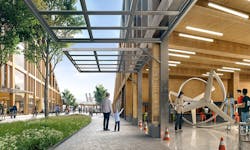Stony Brook University will anchor Climate Exchange campus in New York City
Stony Brook University will serve as the anchor institution for the development of a climate solutions center on Governors Island in New York City.
The university says the New York Climate Exchange will be a first-of-its kind center for developing and deploying solutions to the global climate crisis.
According to the Governor's Island website, the 400,000-square-foot campus will include classrooms, laboratories, research labs, public exhibition space, student and faculty housing, university hotel rooms, and auditorium spaces, serving as an inspiring example of sustainable and resilient design. The campus is expected to create 2,200 union construction jobs.
Newly constructed classroom and research buildings will rise on three acres of the Island’s eastern development zone, and over 170,000 square feet of space within existing buildings, including Liggett Hall and the Fort Jay Theater, will be restored.
The Exchange's Core Partners include University of Washington, BCG, Pratt Institute, Pace University, Georgia Tech, IBM, and GOLES. Affiliate Partners include Duke University, New York University, University of Oxford, Rochester Institute of Technology, SUNY Maritime College, City University of New York, and Moody’s.
The design and operations of The Exchange — conceived by Skidmore, Owings & Merrill in collaboration with MNLA, Buro Happold, and Langan Engineering — will serve as a model for sustainability with a net-zero center.
The key elements of the Exchange:
- Green-designed building space will provide research labs, classroom space, exhibits, greenhouses, mitigation technologies, and housing facilities, including all-electric buildings with on-site solar electrical generation and battery storage meeting 100% of energy demand with net-positive capability to serve the local grid; 100% of non-potable water demand will be met with rainwater or treated wastewater; 95% of waste will be diverted from landfills; climate-resilient design including new buildings will be raised to 18 feet; all new and renovated buildings will be designed to meet Living Building Challenge standards.
- A Research and Technology Accelerator will source and nurture ideas, projects, and ventures dedicated to solving the climate crisis.
- Workforce development opportunities for communities disproportionately affected by climate change — the Exchange will have over 6,000 green job trainees annually once fully operational — ensuring New Yorkers most affected by climate change are well-positioned for new green economy jobs.
- Partnerships and collaborative grant opportunities with community-based organizations working to mitigate the effects of climate change.
- A Citizens Advisory Council, composed of key local stakeholders to ensure that partners’ and neighbors’ voices are heard.
- A self-sufficient development that aims for net positive sustainability.
- Academic and community programs that prepare students for careers focused on climate change solutions and environmental justice.
Video from Stony Brook University:
About the Author
Mike Kennedy
Senior Editor
Mike Kennedy, senior editor, has written for AS&U on a wide range of educational issues since 1999.
